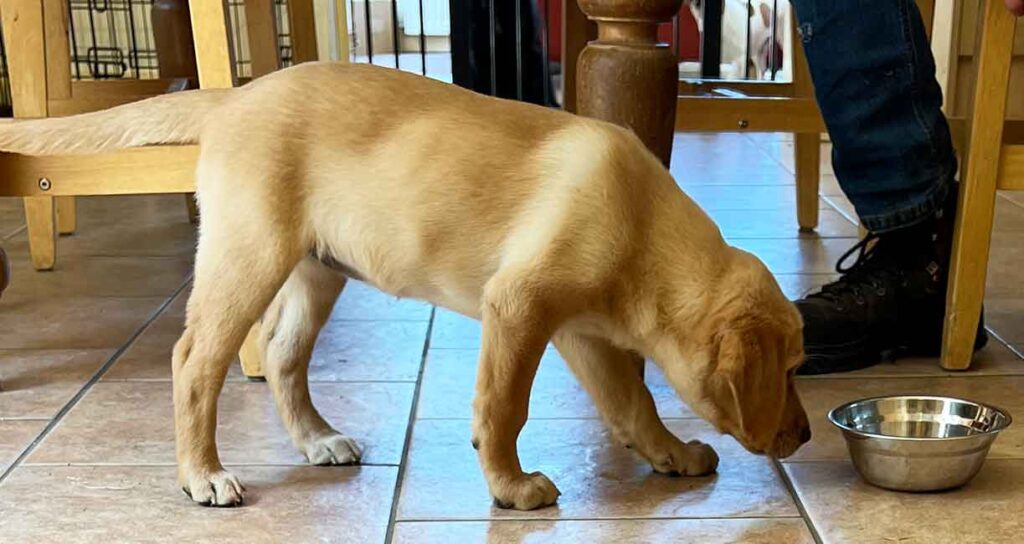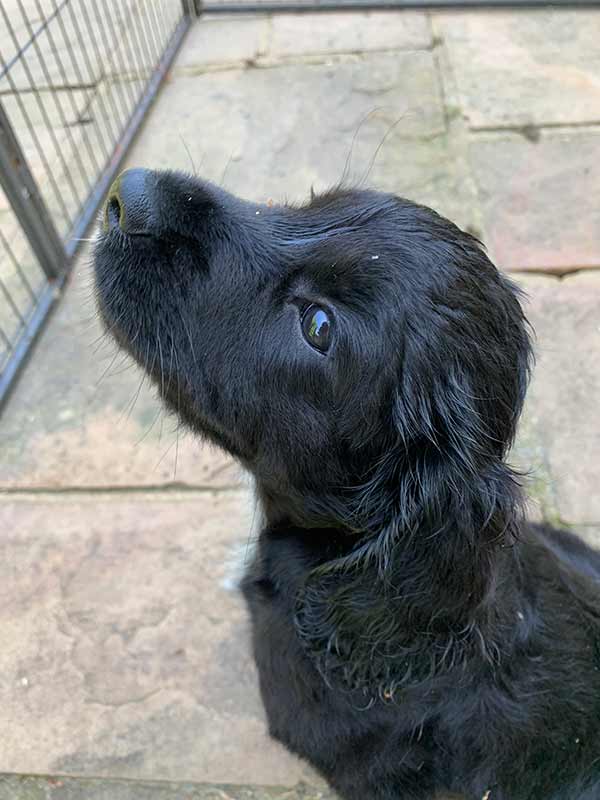
There is a lot of scary information out there, regarding animal feed and nutrition. You can read about dog food recalls and the dangers of a processed commercial diet one day, and then read about the dangers of raw food the next.
And it’s fair to say that there’s a certain amount of propaganda designed to push people in one direction or another when it comes to feeding their dogs.
Fortunately it’s pretty easy to feed a healthy diet to your puppy. So I am going to set out your options and dispel a few myths.
We’ll also talk a bit about feeding different breeds of puppy, from Dachshunds and tiny Chihuahuas, to Rottweilers and Great Danes. Because this is one area where size actually matters.
The first week
For the first week of your puppy’s life, unless they have been on a terrible diet or show signs of being unwell, I suggest you feed your puppy exactly what they were being fed by their breeder.
That’s because they are already stressed by moving home and there seems little point in adding to that stress with a change in diet.
At the end of the first week, if you want to consider making a change there are two basic options available to most puppy parents around the world
Option 1 – Puppy kibble
Option 2 – Raw meat and bones
The differences between them in terms of ‘ease of use’ are significant. And for many puppy parents kibble will be the simplest choice.
I’ll throw my hat in the ring and make it clear that I feed all my adult dogs on a raw diet. But perhaps unusually for a raw feeder, I feed all my puppies on kibble until they are around six months old.
I’ll explain why I do this below. And you can find out what my adult dogs eat in this article: What Do Raw Fed Dogs Eat
Option 1 – Kibble
Puppy kibble is widely available in most parts of the world where many people keep dogs as pets. It stores well, and requires no effort to produce, and no thought to serve up.
You can if you wish, just pour the same kibble in the same bowl every day. Most dogs will do well, and be happy, on this regime. And there is nothing wrong with doing that if it suits you. .

The market for pet foods is a competitive one. Dog food manufacturers employ top nutritionists and invest heavily in maintaining a great reputation through the production of quality products, and incidents requiring product recalls are comparatively rare. As a result, most puppies thrive on commercially produced puppy food.
Option 2 – Raw
Dogs are perfectly designed to consume and digest raw meat and bones. And for the last few decades a thriving community of raw feeders has become established around the world.
The benefits of feeding raw include dogs with sparkly clean teeth and smaller, almost odorless poops that are less offensive to pick up and dispose of. Raw is much more pleasurable for dogs to eat and their meals often last twenty minutes or more rather than a few seconds.
There are many claims for increased health and vigor in raw fed dogs but I’m not sure that any of those are substantiated. And my dogs have glossy coats on either diet
When I first started raw feeding several decades ago you could read all kinds of dire warnings that your dogs will get salmonella, or that their gut will be pierced with bones or that they won’t get a balanced diet, etc, etc.
There are risks to either way of feeding (we’ll talk about those) but by and large, dogs fed on raw thrive in just the same way that dogs fed on kibble thrive.
Why I feed my puppies on kibble
So why do I start my puppies off on kibble, and then transition them to raw at around six months old?
The answer is simply because for the first few months I use almost all my puppy’s food ration up in training.
And it’s really quite difficult (and messy) to do this with raw food.
Convenience and cost
There’s no doubt that kibble is more convenient than raw feeding. And unless you have a continuous supply of raw meat and eggs available as we do on our homestead, then kibble is probably cheaper.
For raw feeding you’ll need plenty of freezer space, and you’ll need to do a bit of planning to make sure your dogs are getting a varied and balanced diet, just as you do for your family.
Risks on both sides
There are some health issues that may be associated with both raw and kibble feeding.
Bloat
Some large deep chested dogs are susceptible to a condition commonly referred to as bloat. Some research suggests that an increased incidence of this condition in some dog breeds, may be associated with dry food.
If you have a large breed puppy and you aim to feed your dog just once a day when they are fully grown, that risk may increase because it means your dog needs to consume quite a large quantity of kibble (which expands in their stomach when they drink) at one sitting.
Dental decay
With little dogs this isn’t an issue. There is however an increased likelihood of dental decay in kibble fed dogs, and this risk may be increased in small dogs like Chihuahuas that often have crowded teeth.
You can probably mitigate this risk with a toothbrush and daily tooth cleaning routine!
Over-feeding
Another risk that is greater with kibble is over-feeding. It’s quite difficult to overfeed a raw fed puppy. When they’ve had enough they just stop eating.
With kibble on the other hand, it’s quite easy to feed too much and end up with a fat puppy, and potentially with a puppy that grows too fast. Overly rapid growth is not a good thing, especially in larger breeds, and may damage their developing bones and joints.
Broken teeth
The main risk to dogs that eat a lot of bones is probably a broken tooth, though in several decades of raw feeding I have not seen such an occurrence.
I have, however, had one occasion when a dog got a small bone stuck in their back teeth, which I managed to extricate by a bit of careful wiggling.
Injury
In theory there are risks to swallowing sharp bones, but in practice this seems to be a vanishingly rare occurrence and not one I have come across.
Infections
The same applies to the risk of infection from raw meat, and of course you need to take precautions to protect yourself and your family when preparing it as you would if you were preparing meat to cook for them.
Most puppies, most families
Here’s the thing. For most puppies in most families, kibble is going to be the best choice.
Don’t let anyone tell you that you have sold out, or that kibble is ‘poisonous’ or any other nonsense that I see online from time to time.
Hundreds of thousands of dogs, probably millions, thrive on kibble. And yours likely will too.
The main benefit of kibble for puppies is that it gives you dozens of training opportunities each and every day. And that makes it so much easier to build a bond with your new friend.
It’s hard to overstate how important this is.
If you really want to raw feed, then go for it! Your dog will love it. But it takes effort.
If you are not bothered either way, why not keep life simple, and stick to kibble for now.

Free Training Tips
Get Pippa's free dog training tips delivered to your inbox

 The Internet: A Dog Training Minefield
The Internet: A Dog Training Minefield